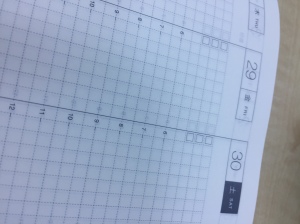*warning: apologies for the long post and heavy pictures*
I’ve meaning to do this post for a while now but have been putting off because I wanted to do a detailed post. More importantly I wanted to make sure that the system worked for me before I started proclaiming that I have found a work planner that works.
I love planners with rings, always have and always wil. But last year I decided to make an exception and try out a couple of other models for work. I need an A5 size but an A5 Filofax was just getting too heavy.
After some searching and try-outs, I settled on the Hobonichi Techo Cousin. I tried the usual suspects… Moleskine, Levenger Circa, simple daily diaries. But, the Hobonichi has stuck with me from April and here is why…
Weight, Thickness, Paper, Cover – Because the Hobonichi is made from the famous Tomoe River Paper, despite having 4 kinds of diaries, it is amazingly light and compact. [picture / weight] I’m also using one of their Nylon type covers which doesn’t add to the weight at all. The cover has several pockets and two page ribbons, which is really very helpful. Not only is the paper lightweight, but it’s surprisingly nice. It’s not stark white and actually holds up to fountain pen quite well. There is some see through but I was really surprise at how insignificant it is.

Layout – for most people this diary will be a dream. It has four different kinds of diary layouts. All that choices can be a little confusing and I’m still trying to find a system to make them all work. [Pictures below]
- Daily Pages – The daily pages are nice. They have a space for MITs, schedule, to-do and notes. But the page can be used anyway you want. I only use the daily pages on really busy days. Otherwise, I use them for meeting notes or reference notes. So I don’t always maintain the date that I’m writing on.

Daily Pages - Vertical monthly list – I use this as an Index. Since I use the daily pages for various topics writing, I will use this list to put down the topics corresponding to the date. This helps me find information when I need it.

- Monthly Grid – I was lost at first with what to use this for. Since my calendar is in my Filofax. This seemed like a waste for me. But then I realized, I have a lot of sales call reports / meeting minutes that I have to write. I started to use this grid to put in meetings that actually took place so, a type of log of meetings or major activity I did that day.
- Vertical Weekly Schedule – This is my main functional part of the planner. I don’t schedule tasks on this but rather use it as my weekly task list/ brain dump. There’s a nice portion above every day for 3 Most Important Tasks. I haven’t found a use for that as yet.

So far, this planner is working great. It’s the longest I’ve used a bound planner in a while and there seems to be plenty of space for everything without being bulky.
The only thing I do not like about this planner is that the Monthly Grid and Vertical weekly schedule are both Monday-start layouts. Since I live in the UAE, where our week starts on Sunday, I prefer using planners with Sunday-start layouts. Despite this, I love the look and feel of the Hobonichi so much that I’ve stuck with it. I’ve already ordered and received the 2017 version. I don’t know if I will use this next year but I certainly want one in my collection.
P.S. I still use a Filofax Personal (actually a Compact) for my diary and my personal notes. I didn’t want to lug around my work lists and notes, so I got a separate planner. One important thing I’ve maintained is one Calendar… in my Filofax which I can always carry. I will try to do a set up post on that at another time.
Disclaimer: All opinions are my own. I am not affiliated with any of the products mentioned.
This is nice! It looks very inviting to writing 🙂
LikeLiked by 1 person
Oh yes. I love the paper. It’s so smooth and lovely for fountain pens.
LikeLike